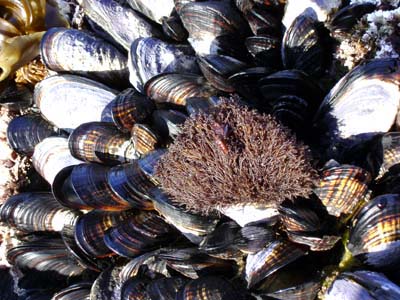
The Brillo Pad Algae
Ecology
Endocladia muricata growing on mussel shells.
Barnacles growing within a clump of Endocladia muricata.
Endocladia muricata found in the high intertidal at Botanical Beach, Vancouver Island, British Columbia, Canada (photo by Andrea Dingeldein) |
|
|
1) O'Clair, Rita M. and Sandra C. Lindstrom. North Pacific Seaweeds. Alaska: Plant Press. 2000.
2) Paine, R.T. 1969. The Pisaster-Tegula interaction: prey patches, predatory food preference and intertidal community structure. Ecology 50:950-961.
3)Hunt, L.J.H. and M.W. Denny.2008. Desiccation protection and disruption: a trade-off for an intertidal marine alga. Journal of Phycology 44:1164-1170.


